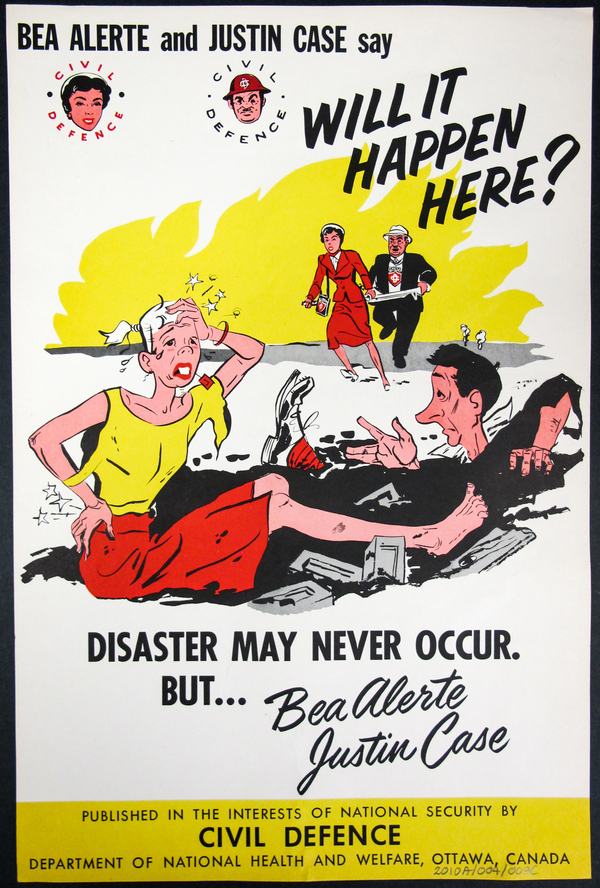Selling War on the Homefront
“Will it happen here?” was the question posed to Canadians in this civil defence propaganda poster commissioned by the Information Service of the Department of National Health and Welfare in the early 1950’s [Figure 1]. The poster depicts the cartoon mascots of Civil Defence Canada - Bea Alerte and Justin Case, their names a linguistic play on the demand to be alert just in case an emergency might arise. Using a vibrant colour palette to draw the viewers’ attention, the poster depicts Bea Alerte and Justin Case hurrying to the aid of injured civilians in the aftermath of what appears to be a bombing. This image was one of fourteen created as part of a Canada-wide public advertising campaign that aimed to convince Canadians of their responsibility to participate in civil defence activities[1]. With the rapid expansion of mass communication in the early 20th century, marketing and the visual strategies it deployed became a popular method for influencing public behaviour. As the Canadian government soon realized through their relationships with a newly burgeoning advertising industry[2], propaganda was a good way to sell war.
During World War II, the marketing of war via propaganda posters fulfilled a dual purpose: it boosted morale and delivered popular messaging designed to encourage Canadians to take their commitments to nation building seriously.[3] Indeed, the war effort relied on such public support to realize its goals, achieved through tangible means such as the purchase of war bonds[4]. But as we explore in this digital exhibition, war-time propaganda campaigns also delivered crucial lessons about citizenship and domestic responsibility on the home front of nation building. As such, propaganda posters deployed visual strategies to communicate cultural norms that tapped into already existing values and perspectives. As Bray (1995) argues in his analysis of Canadian World War II poster campaigns, these graphic messages can be analyzed as cultural artifacts - objects of material culture that provide visual evidence of public opinion at the time. But crucially, Bray suggests, propaganda posters “were, in fact, active agents in this process of change. As part of society's cultural resources, the images used in these posters influenced the way society made sense of the social and ideological upheaval caused by the war”.[5] Bringing Bray’s insights to our study of Canadian propaganda poster campaigns during the Cold War, we explore the pedagogical aspects of graphic messaging, particularly how these posters instruct gender norms through their use of visual metaphors. Propaganda posters are elements of visual culture that reflect, influence, and produce the material world. We therefore ask, what kind of social, cultural and political work were they made to do?
References
1 F.F. Worthington to Provincial Civil Defence Coordinators, June 29, 1954, Library and Archives Canada RG 29, Vol. 56, File 100-5-1
2 H.W. Adams, Director, Information Services Division to F. Dostie, December 27, 1955. LAC RG 29, Vol. 102, File 180-8-1
3 B. Bray, “From flag-waving to pragmatism: Images of patriotism, heroes and war in Canadian World War II propaganda posters,” Material History Review 42 (Fall 1995): 75-86, 75.
4 “Victory Loans and War Savings,” Wartime Canada, accessed July 25, 2021, https://wartimecanada.ca/categories/victory-loans-war-savings.
5 Bray, 76.
